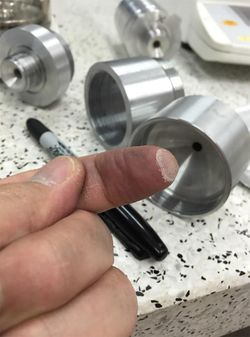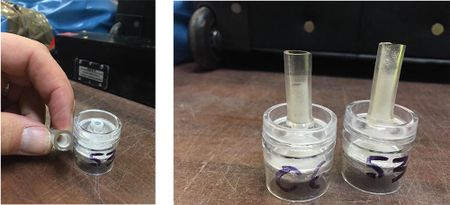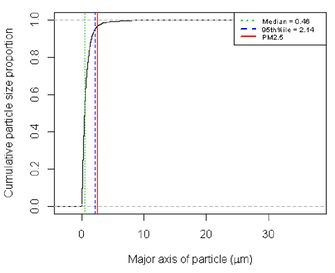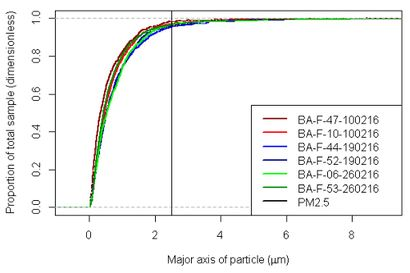OR/16/028 Results
| Beriro, D J, Field, L P and Cave, M R. 2016. Validation of a gravimetric PM2.5 impactor using particle sizing techniques. British Geological Survey Internal Report, OR/16/028. |
Summary of the samples collected
A summary of the samples collected, collection dates, mass on the filter and concentration of suspended particulate matter is shown in Table 3.
The results show that the total mass of suspended particulate matter collected on each filter varied from 3.8 to 9.2 mg and that the concentrations ranged from 75 to 183 µg m-3. These values reflect the dusty nature of the environment used for monitoring. A photograph of the author installing the monitoring station in the primary crusher shed is shown in Figure 5.
| Sample number | Description | Collection date | Filter mass (mg) | Filter and sample mass (mg) | Sample mass (mg) | µg m-3 | Analysis type |
| BA-F-47-100216 | Filter # 47 | 10/02/2016 | 22.695 | 26.463 | 3.768 | 74.762 | SEM STEM |
| BA-F-10-100216 | Filter # 10 | 10/02/2016 | 22.083 | 26.334 | 4.251 | 84.345 | SEM STEM |
| BA-F-44-190216 | Filter # 44 | 19/02/2016 | 22.809 | 27.311 | 4.502 | 89.325 | SEM STEM |
| BA-F-52-190216 | Filter # 52 | 19/02/2016 | 22.733 | 27.434 | 4.701 | 93.274 | SEM STEM |
| BA-F-06-260216 | Filter # 06 | 26/02/2016 | 22.788 | 31.161 | 8.373 | 166.131 | SEM STEM |
| BA-F-53-260216 | Filter # 53 | 26/02/2016 | 22.970 | 32.190 | 9.220 | 182.937 | SEM STEM |
| BA-OS-ALL-150316 | PM2.5(oversize) | Combined | na | na | na | na | LD |
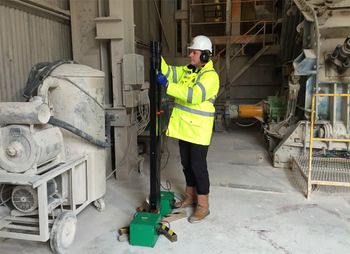
During the sampling (field and laboratory) a number of observations were made which are considered to be important and relevant to this validation report. These are:
- The primary crusher is a very dusty area which meant that the sampling was representative of high suspended particulate matter conditions present in a limestone quarry;
- When the impactor was dismantled there was a noticeable accumulation of particulate matter (not quantified) remaining on the funnel section of impactor (Figure 6);
- When the filter cassette was removed there was a noticeable accumulation significant mass of particulate matter (>1 mg or over 10% of the total mass recorded on the filer in the tube connecting the sampler inlet to the cassette (Figure 7). The mass was quantified by weighing the tube, cleaning it with dry lint free tissue and then and re-weighing. The difference was assumed to be the net mass of particulate matter present in the tube; and
- When the petroleum jelly was re-applied to the impactor it was difficult to ascertain whether the mass applied was the same each time, although it is not known if this factor is an important consideration
SEM and STEM
Microscopy
The filters were thickly coated in particulate matter with filters 53 and 06 from the final week (26th February 2016) of collection being the most thickly coated. Both of these filters displayed delamination in the centre of the filters. The coating for these filters was also lighter grey in colour compared to the previous four filters. SEM analysis of the uncoated, stub-mounted filter papers identified particles larger than 2.5 µm in diameter in all samples (refer to Appendix 1 for examples), although imaging suggests that the majority of particles are below this diameter.
The x2 dilution proved optimal for STEM analysis, and these grids were used for STEM analysis in all cases. Some aggregation of particles was observed: this may be due to flocculation during the dilution process or agglomeration in ambient air prior to sample collection. Larger particles were checked under secondary conditions to verify if they were a discrete particle or an aggregate (e.g. Plate 2 and Plate 3).
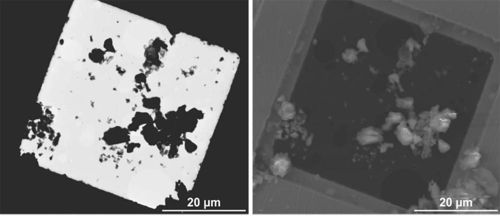
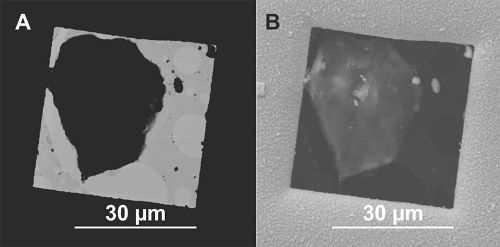
Exploratory data analysis
The particle size data derived from the STEM analysis is summarised in Table 4. The median value for the combined data for all filters is 0.46 µm with a mean of 0.74 µm (n=6 343) — these values indicate a strong positive skew. The minimum (0.3 to 0.4 µm), median (0.35 to 0.54) and 95th percentile (1.82 to 2.41) values are reasonably consistent between filters, whereas the maximum has far greater range (8 to 35 µm).
| Filter # 47 | Filter # 10 | Filter # 44 | Filter # 52 | Filter # 06 | Filter # 53 | All | |
Visit 1 |
Visit 2 |
Visit 3 | |||||
| Minimum (µm) | 0.03 | 0.03 | 0.03 | 0.03 | 0.04 | 0.04 | 0.03 |
| Mean (µm) | 0.59 | 0.72 | 0.83 | 0.83 | 0.84 | 0.70 | 0.74 |
| Median (µm) | 0.35 | 0.47 | 0.52 | 0.54 | 0.53 | 0.43 | 0.46 |
| Maximum (µm) | 8.44 | 10.91 | 12.54 | 19.17 | 34.84 | 14.56 | 34.84 |
| Standard deviation (µm) | 0.74 | 0.84 | 1.02 | 1.17 | 1.54 | 0.91 | 1.02 |
| Relative standard deviation (%) | 125 | 117 | 123 | 142 | 182 | 129 | 139 |
| 95th percentile (µm) | 1.82 | 2.02 | 2.41 | 2.26 | 2.15 | 2.08 | 2.14 |
| n | 993 | 1334 | 922 | 850 | 760 | 1484 | 6343 |
The distribution of particle size for each filter is presented as density plots using log x-axes in Figure 8. The plots show the data present a strong positive skew and that the majority of particles are <2.5 µm.
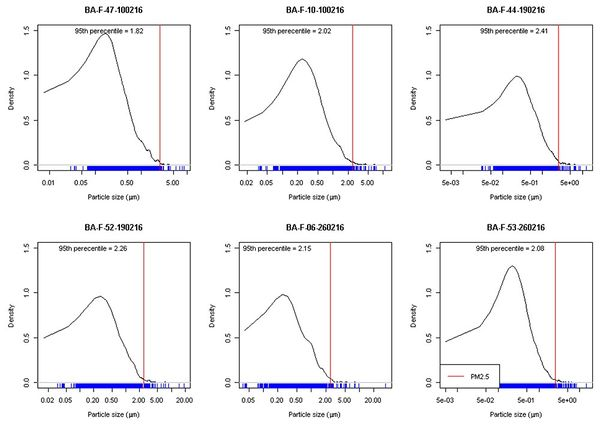
The combined all sample and individual filter data are presented as a relative cumulative frequency distribution in Figure 9 and Figure 10 respectively. These plots show that most of the particles are below 2.5 µm. The relative cumulative frequency distribution is very similar for each filter, suggesting performance between monitoring stations and visits is consistent.
Further analysis of the repeatability of the particulate matter collected by the two impactors during each of the three sampling rounds has been made using percentiles (0 to 99th percentile at 0.1 percentile intervals). Percentiles were used to smooth the effect of extreme values (principally the upper region of the range including the maximum values) in the raw data. Figure 11 shows these percentiles as bi-plots for each sampling visit demonstrating that there is reasonable agreement with minimal variation in the distribution of the particle size collected by each monitoring station within and between visits. Linear models were fitted to each visit dataset to compare the relationship between the two impactors. Each model produced an R-squared >0.95, suggesting good repeatability within sampling visits.
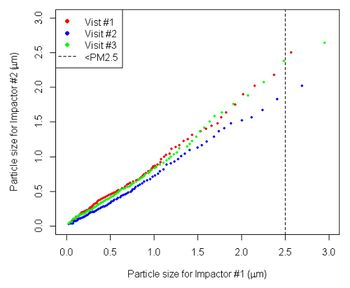
The medians and the 95th percentile CIs of dPA of particles measured for each filter were estimated using bootstrap resampling. The resampled medians and the CIs are presented in Table 5 and Figure 12. The results of the resampling show that there are some significant differences between some but not all of the CIs. These are probably due to slightly different conditions at different time periods (e.g. humidity, day to day variations). The overall CI range of 0.3 to 0.6 um for all samples suggests a good level of precision in the particulate matter collected by the DS500X monitoring system both between parallel stations and visits.
| Visit | Filter | Resampled lower confidence interval (µm) | Resampled median (µm) | Resampled upper confidence interval (µm) |
| 1 | #47 | 0.30 | 0.35 | 0.38 |
| #10 | 0.45 | 0.47 | 0.50 | |
| 2 | #44 | 0.48 | 0.52 | 0.59 |
| #52 | 0.50 | 0.54 | 0.57 | |
| 3 | #06 | 0.48 | 0.53 | 0.60 |
| #53 | 0.40 | 0.43 | 0.46 |
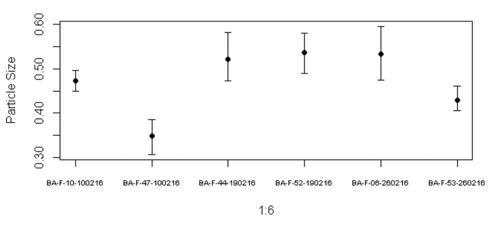
Laser diffraction particle size analysis
The certificate of analysis for the LD conducted by Escubed Limited is presented in Appendix 2.
A summary of the particle size distribution plotted on a log x-axis is presented in Figure 13. The results show that the majority of particles present in the oversize sample are >2.5 µm, where the median (Dv50) is 4.01 µm.
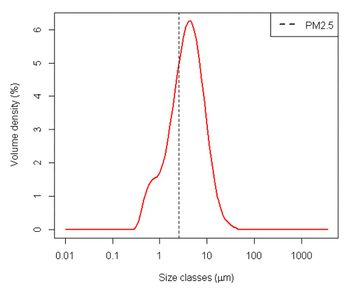
Table 6 shows the Dv (10), Dv (50) and Dv (90) for the sample together with the standard deviation and coefficient of variation (%CV), which show the repeatability between measurements. It is stated in ISO 13320 that the %CV should not exceed 3% around the median and 5% around the extremities. Below 10 µm, these maximum values should be doubled.
| Sample Name | Particle Size (µm) | ||
| Dv (10) | Dv (50) | Dv (90) | |
| 16-079-01 BA-OS-ALL-150316 Rep 4 | 1.06 | 3.98 | 10.73 |
| 16-079-01 BA-OS-ALL-150316 Rep 4 | 1.07 | 3.99 | 10.72 |
| 16-079-01 BA-OS-ALL-150316 Rep 4 | 1.07 | 4.00 | 10.74 |
| 16-079-01 BA-OS-ALL-150316 Rep 4 | 1.07 | 4.01 | 10.77 |
| 16-079-01 BA-OS-ALL-150316 Rep 4 | 1.07 | 4.02 | 10.71 |
| 16-079-01 BA-OS-ALL-150316 Rep 4 | 1.07 | 4.02 | 10.64 |
| 16-079-01 BA-OS-ALL-150316 Rep 4 | 1.07 | 4.02 | 10.66 |
| 16-079-01 BA-OS-ALL-150316 Rep 4 | 1.08 | 4.02 | 10.62 |
| 16-079-01 BA-OS-ALL-150316 Rep 4 | 1.08 | 4.03 | 10.58 |
| 16-079-01 BA-OS-ALL-150316 Rep 4 | 1.08 | 4.03 | 10.55 |
| Average | 1.07 | 4.01 | 10.67 |
| Standard Deviation | 0.00 | 0.02 | 0.07 |
| %CV | 0.41 | 0.40 | 0.70 |
